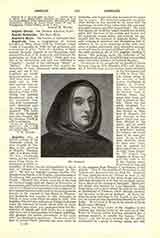

Angelicals, the, a congregation of women founded at Milan about 1530 by Countess Luigia Torelli of Guastalla (d. 1559) for the protection and reclamation of girls. Under the direction of Saint Antonio Zaccaria, founder of the Barnabites, they adopted the Rule of St. Augustine, and obtained the approbation of Paul III (1534). Their garb was that of the Dominicans, and each was addressed as “Angelica”, instead of the customary “Sister” or “Mother”. Not being cloistered, they assisted the Barnabites in their missionary work until abuses arose, and one of the Angelicals set herself up as a prophetess. In 1557 they were cloistered, and in 1625 their statutes were revised by St. Charles Borromeo and confirmed by Urban VIII. During the political disturbances early in the nineteenth century their foundations were destroyed and the congregation disappeared. The Institute of the Guastallines also founded by the Countess Torelli is still in existence.
F. M. RUDGE

